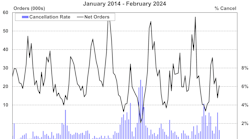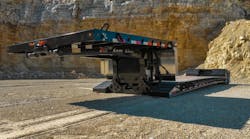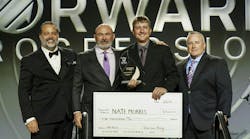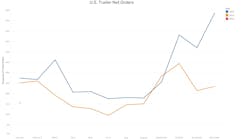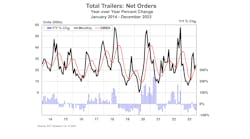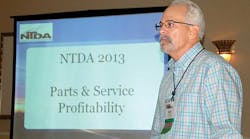Gross profit is the quickest, most reliable way to positively impact long-term profitability, according to Dave Durand, vice-president of aftermarket parts for Great Dane Trailers.
In “Parts and Service Profitability,” Durand said dealerships should work on sales and operational efficiency (or “expenses,” in old-school terminology), but gross profit “gives you a big bang for the buck and is easily sustainable.”
In a typical parts department that does $2 million in sales, there is a gross profit of $500,000 (25%), expenses of $440,000, and a net profit of $60,000 (3%).
If the dealership increases gross profit 1%, that’s a $20,000-per-year net profit. To achieve that same result, you’d have to increase sales 33% or reduce expenses $20,000.
Based on statistics compiled by Keith Ely and Associates, the industry parts benchmarks are 26% for retail and 32% for the shop and the industry service benchmarks are 72% for customers and 72% internally.
Parts pricing can be established by part number, vendor, or product group, but he said just about everybody does it by part number in one way, shape, or form.
“The mark-up method is most common to get the sale price over cost, but here’s where it gets fuzzy,” Durand said. “I have run into some dealerships where people can go in and change the average price. If you do that outside of the transaction, then you’re messing with your dollars in inventory. You don’t want to do that.”
Other ways:
• Replacement (price driver). “This is supposed to be your current price you pay from your supplier. That is where your PO is driven off and then when you receive it, it comes into the average. Replacement costs can vary. Vendor price increases being what they are, some vendors had decreases, and you’re driving price off replacement. Your parts manager comes in and says, ‘Hey, I just got 10% off on a product line.’ You say, ‘Great, I’d love to save 10%.’ You actually lost. You had a 10-cent item and now you buy for five. You had a mark-up on it so you were selling it for 20 and now for 10. You just lost 10 cents every time you sell it.”
• Standard (optional price driver). “I suggest you take a look at it if you don’t have it already. This is a manual cost field that you adjust and manipulate. It doesn’t automatically change. It changes when you tell it to change.”
Durand said one good way to raise margins working just in parts is freight factor.
“Your inbound freight is supposed to be the cost of goods sold,” he said. “If you can get the inbound freight amount, if you can look at a percentage over your entire product line and say, ‘My inbound is 2% across everything I buy,’ and you add 2% to this field to cover it, you just raised gross profit more than 2%.”
Establishing parts pricing:
• Market determines price. “The single biggest seller is that brake drum that fits the tractor and trailer. It’s a veritable race to the bottom. I saw a price the other day for $40. Who wants to play in that mess?
• Velocity pricing. “The faster the part turns, the lower the price. But be aware there are fast-moving parts you should not lower the price on. Be careful about using this strictly when you’re pricing product.”
• Cost matrix pricing. “The lower the cost, the higher the price it should command.”
Durand said that increasing parts gross margin involves analyzing your data, adjusting and assessing impact, implementing, and repeating.
Analyzing data via Excel involves putting the part number and description in the first two columns, then creating columns for total sales units and dollars, gross profit (12 months of data), average, replacement and standard costs per part number, system mark-up, sell price, and gross percentage per part. Make new columns for new standard cost, mark-up, sell price, and new projected gross profit percentage
“If your goal is to raise gross profit 2%, you keep playing until you get there,” Durand said. “Any time you make a change in mark-up or standard cost or add freight factor, you can see what’s happening. When you’re comfortable and your parts people are comfortable, you can go ahead and implement it.”
Consider:
• Proprietary parts. “The rules of velocity pricing do not apply here if they don’t have to. If you’re selling 1000 proprietary hinges a month and velocity says you should take that margin down 10 points, don’t do it unless you have to.”
• Special orders/buyouts. “How do we mark those up? Make sure you’re aware there is some margin to be gained in here.”
• Price overrides/contracts. “In some dealerships, parts people have availability to override price at the point of sale to give them flexibility when in a competitive situation. I think you have to have that.”
• Avoid hard-quote contracts.
• Shop parts. “It’s the mix that’s really driving the margins.”
• Internal parts. “This is always part of the discussion. I know several dealerships that charge a higher mark-up internally than externally. Why do they do that? To feed the house. It brings more money to parts and service departments and into the operation.”
• Vendor price increases. “When is the best time for you to raise the price to customers on parts? When a vendor gives you a price increase. And is it OK to add one-quarter point or a half-point to the house on that vendor line? Best time to do it.”
• Freight sales. “If you can mark freight up, have at it. A lot of guys don’t do it. But if you have a freight bill in and you cut a deal with the carrier and he gives you a 25% discount, nothing says you have to pass that on.”
• Freight factor. “If my parts in the dealership can only see standard cost and I already have 2% built in, and they discount it, and they know what the cost is and they only see the standard, you’ve got a winner.”
• New higher margin products.
• Mark-up versus margin. “People don’t understand the difference between mark-up and margin. They think that when they mark something up 1.3 they are making 30%. They are not. They are making 25%. If they want to make 30, they’ve got to mark it up 1.45.”
In terms of service departments, he’s against published labor (door) rates.
“I’m trying to figure out personally how to eliminate it,” he said. “I feel the labor rate should vary by the complexity of the job, and that when the customer asks for your labor rate, what he’s asking for sometimes is to compare yours to the other guy’s.
Other tips for the service department:
• Effective labor rate. “We don’t do this well. It’s total labor sales divided by labor hours billed. So if you have $100 in a labor sale and you have 10 hours, your effective labor rate is $10. It doesn’t matter what your published labor rate is. What is it you’re actually bringing in the door for an effective labor rate? If you’re not doing it, start doing it, because it works. Once you know exactly what kind of labor rate you bring in across all service work, you can start to say, ‘How do I move that needle up? How do I take that effective labor rate from $10 to $15 an hour?”
• Make labor the only variable. “The tendency for service managers is to play with variables to make the labor rate look good. We’re taking labor and moving it to another job because we didn’t make hours on this. We’re going back to the parts department and telling them, ‘We want help on the price to make labor look better.’ Don’t do it. You’ll never get a solid effective labor rate if you’re playing with it. Lock and load your parts prices, lock and load your shop supplies and every variable except for labor, and then you get a true picture of what the effective labor rate is. You’ll never make progress if you don’t lock it.”
• Repair estimates. “Estimate every job. Most customers aren’t asking us, ‘What is your parts price and labor price?’ They just want to know what it costs to fix a trailer. So you can deliver that in the estimate every time. After you’ve done the job, if you haven’t estimated it and the customer gets the trailer back, you’re negotiating without a hostage. In the middle of the job if something else goes wrong, and you need to fix something, you call the guy and estimate it. Don’t do anything without an estimate.”
• Use Standard Repair Times (SRTs). “Your OEs can help with that. The best way to do SRT times is three columns: what you want to get, the midpoint, and lowball. Focus on getting the top end but you can come down the list.”
• Charge for diagnostic time. “We don’t say, ‘Well, it’s probably going to take two hours and my rate is $70 an hour.’ You say, ‘We have a flat charge to diagnose electrical problems and its $125, Mr Customer.’ I know some shops that waive that fee if the customer allows them to repair the trailer.”
• Speed wins. “How many times have you gotten an estimate back to the customer and some competitor has already picked the trailer up? Why? Because he was back first with the price. Not necessarily because it was cheapest. He wants to know what it will cost to fix the trailer and he wants it now.” ♦
